On Thursday morning, Gerry Thompson, who won Pro Tour Nashville in 2017, finished in the Top 8 of three Pro Tours along with the Top 8 of 10 Grand Prix events, and famously boycotted the 2018 World Championship to advocate for better conditions for Pro Players, dropped this bombshell on Twitter:
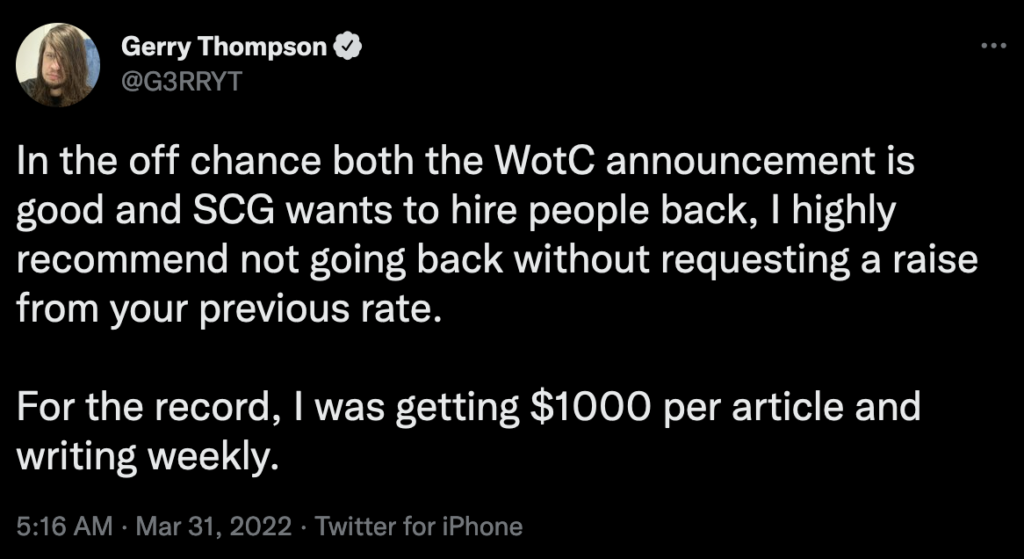
It’s safe to say that most people’s initial reaction was something along the lines of “$1,000 is a lot of money.” That’s a fair assessment; it is a lot of money. $1,000 would be life-changing for the majority of Americans who are currently living paycheck to paycheck. It could help reduce food insecurity. It could help pay down crippling debt. No one should feel bad or be shamed for thinking that $1,000.00 USD is a lot of money. It absolutely is.
But this brings us to the second thought that some people may have had, and several people shared publicly on Twitter: “That’s too much money to write about a card game.” This, on the other hand, is not a fair assessment. Instead, this reaction is more likely the result of envy, anger, or both. The average US household income is just under $70,000 annually and Gerry’s article commission would put him at about $50,000. Many readers of the tweet earn roughly the same amount Gerry was earning—but they’re not writing about a card game.
We see this kind of reaction across the board in response to jobs like retail positions, or restaurant workers, or day laborers. The idea is that there is a certain kind of work that should inherently be less valued compared to the rest of the world’s occupations. You’ve probably heard the term “unskilled labor” or “blue-color jobs.” The continued push of propaganda implying that this kind of employment isn’t worth as much as “whatever it is you’re doing” has resulted in the exact kind of reaction people had to Gerry’s tweet. “Why should Gerry make so much money writing about Magic when I don’t make as much (or I barely make more) for doing ?”
The Real Work of Content Creation
The reality is that, rather than being overpaid, Gerry Thompson was likely underpaid for his contributions to Star City Games. This conclusion requires understanding the effort required to create content weekly, how the publisher markets that content, and how much revenue it generates. Once we dive into each of these facets of the Magic content world, it should become clear whether or not Gerry was fairly compensated for his articles—and whether or not you, if you happen to be a content publisher, should consider putting some money aside to commission work from the former Pro Tour champion himself.
Gerry Thompson was an incredibly prolific writer for Star City Games. According to Star City Games, from May 7th, 2008 to February 25th, 2022, Gerry Thompson wrote 1,294 articles for the site. That’s a period of roughly 166 months—just shy of 14 years—in which Gerry was writing an average of 7.8 articles per month. If you take out his six-month internship with Wizards of the Coast, you push that average up to over eight articles per month. That is a significant body of work, and a testament to his work ethic, consistency, and skill as a writer.
Content creation is work. Full stop. It isn’t a hobby. It isn’t a leisure activity. It’s a job. If you’re creating content on a topic you find personally enjoyable to think about, then maybe it’s a fun job, but it’s still work. Content creation is research work, journalism work, communications work, public relations work, and marketing work. It’s negotiating with your editor and your publisher and whoever else has a stake in your output. Content creation is work and deserves fair compensation.
Some work is easy to identify because it’s confined to a specific set of boundaries. Retail work is an example of this. You arrive for your shift, perform a set of tasks, and then your shift ends. In theory (I understand plenty of retail jobs don’t function ideally) your work is isolated to the hours of effort between the time you clocked in and clocked out.
Content creation is not the kind of work with obvious boundaries. It’s the kind of work that consumes your thoughts during time you didn’t put aside to write articles (or record podcasts, edit videos, etc.). As many of Gerry’s colleagues and supporters pointed out on Twitter, he has to eat, sleep, and breathe Magic in order to consistently produce such high quality content. Imagine eating breakfast while reading tournament reports, making lunch while pouring over decklists, and winding down in the evening with a glass of your favorite beverage and firing up Arena to play just a few more test matches with that sideboard tech you came up with while you were out at the supermarket.
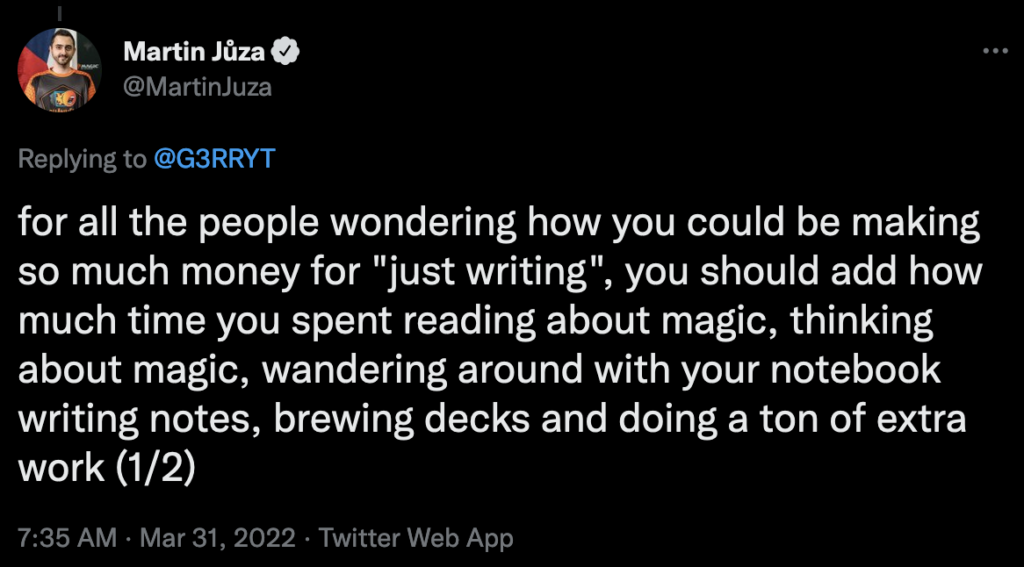
If you’re a contractor and you’re remodeling someone’s kitchen, or you’re a mechanic and you’re rebuilding someone’s transmission, you bill them for the hours of labor that you have to exert to complete the agreed task. Framing Gerry’s compensation as “$1,000 per article” doesn’t give us a full view of the labor being compensated because the context is the finished product, not the billable hours.
If Gerry spent 10 hours working on an article he earned $100 per hour. That’s on par with some lawyers and healthcare professionals. It’s more than most senior engineers make. If Gerry spent 20 hours working on an article he earned $50 per hour, which is about what engineers earn. If he spent 40 hours working on an article that hourly rate drops to $25, a bit less than a teacher earns in New York City and double what a teacher earns in Texas (look it up). If Gerry spent 60 hours working on the article his wage would be $16.67, which is just above that $15 minimum wage everyone keeps talking about (it’s not enough). Lastly, if Gerry spent 80 hours working on it he’d be earning $12.50, just about the starting pay for an associate at Home Depot in New York.
I don’t know how much time Gerry spent on each article. It’s probably hard to estimate, maybe even for Gerry himself. Regardless, once you retrain your brain to consider the billable hours instead of just the finished product, the wage can be seen from a different perspective. Is content creation worth as much as flipping burgers? Is it worth as much as preparing legal briefs? We’ll talk more about how much content creation is worth, but before we do I want to talk about how content is marketed.
Content is Marketing

This isn’t a friendly biography on Wikipedia or as part of a news report. This is the biography from Gerry’s author page over at https://articles.starcitygames.com/author/gerry-thompson/. Normally I would have put that URL behind a hyperlink, but I wanted to put it out there. Many people don’t understand how the internet works, but let me let you in on one little secret: everything in marketing is about Search Engine Optimization, aka SEO.
Why use author/gerry-thompson instead of author/?id=72? You actually can get Gerry’s articles from a search page that looks like this: https://articles.starcitygames.com/?&from=01/02/2022&to=04/02/2022&s=&author_id=658&tag=&categories=. You are served a similar list of articles, but if you go to Google and type in “Gerry Thompson Star City Games” guess which page you’ll find?

Star City Games has a vested interest in marketing their content creators, and ensuring pages like this show up at the top of the list. Gerry’s LinkedIn profile for example is just as valid a result for “Gerry Thompson Star City Games”; if I was someone in publishing looking to get in touch with Gerry, that might be what I was actually looking for. But Star City Games wants their links at the top, and part of that is including Gerry’s name in the URL.
How many people do you think Google Gerry’s name?
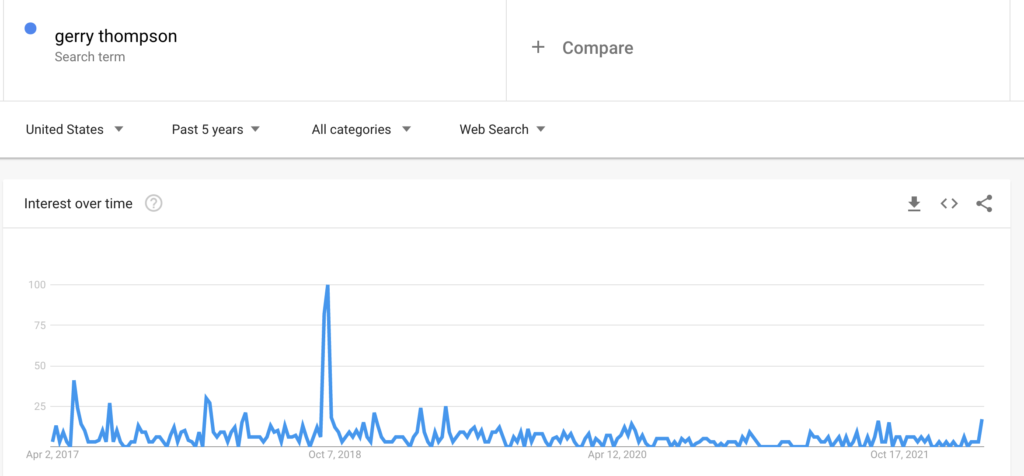
Can you spot the time Gerry announced he was boycotting the Magic World Championship?
You can find out from Google how popular a search term is, and you can compare it to other search terms. I could compare Gerry’s popularity to other Magic pros all day, and in fact I spent more time than I’d like to admit doing exactly that (journalism!). I will say this though: the only other pro player/content creator I found who was more popular than Gerry over the past five years on Google searches was LSV. (I should make the distinction that, while LSV trends higher than Gerry Thompson on Google, Luis Scott Vargas as a search term does not.)
If you run a website like Star City Games, one of your top priorities is to get people to come to your site. When you have a content creator who is as popular as Gerry has been, and as popular as he’s consistently been, you basically get free marketing from Google. Now, don’t get me wrong, Star City Games itself as a topic is far more popular than Gerry is, but that doesn’t change the fact that people searching for Gerry are being directed to Star City Games.
Marketing normally has a very large budget. While I don’t know how big the marketing budget is at Star City Games, we can safely assume it’s substantial. Marketing doesn’t always pay off. For example, Star City Games may have over 66,000 followers on Twitter, but their tweets don’t get much engagement. People may be seeing them, but few are liking, replying to, or retweeting their content. Paying a social media manager to push tweets, or paying for promoted tweets, could be a gamble.
But having Gerry Thompson on your staff can generate consistent traffic, with spikes when Gerry performs well at tournaments. This is why so many companies have begun moving more of their marketing money to influencers and letting them handle social media. Gerry has 40 thousand followers, less than two-thirds the following of Star City Games; but whereas SCG’s social media is almost devoid of engagement, Gerry’s tweets typically generate dozens of interactions with his followers. This is because not only Gerry a swell person who’s a good follow on Twitter, but he isn’t a faceless corporation either.
So Gerry works hard. Gerry brings users to the site through his own social media and just by existing as a search term on Google. What’s it all actually worth and how much should Star City Games, or any content publisher, compensate him for his effort? That depends, in part, on how Star City Games turns Gerry’s content into revenue for the company.
The internet is full of fun information that you can look up such as celebrity birthdays, the populations of small countries or large cities, and the approximate revenue of large corporations.
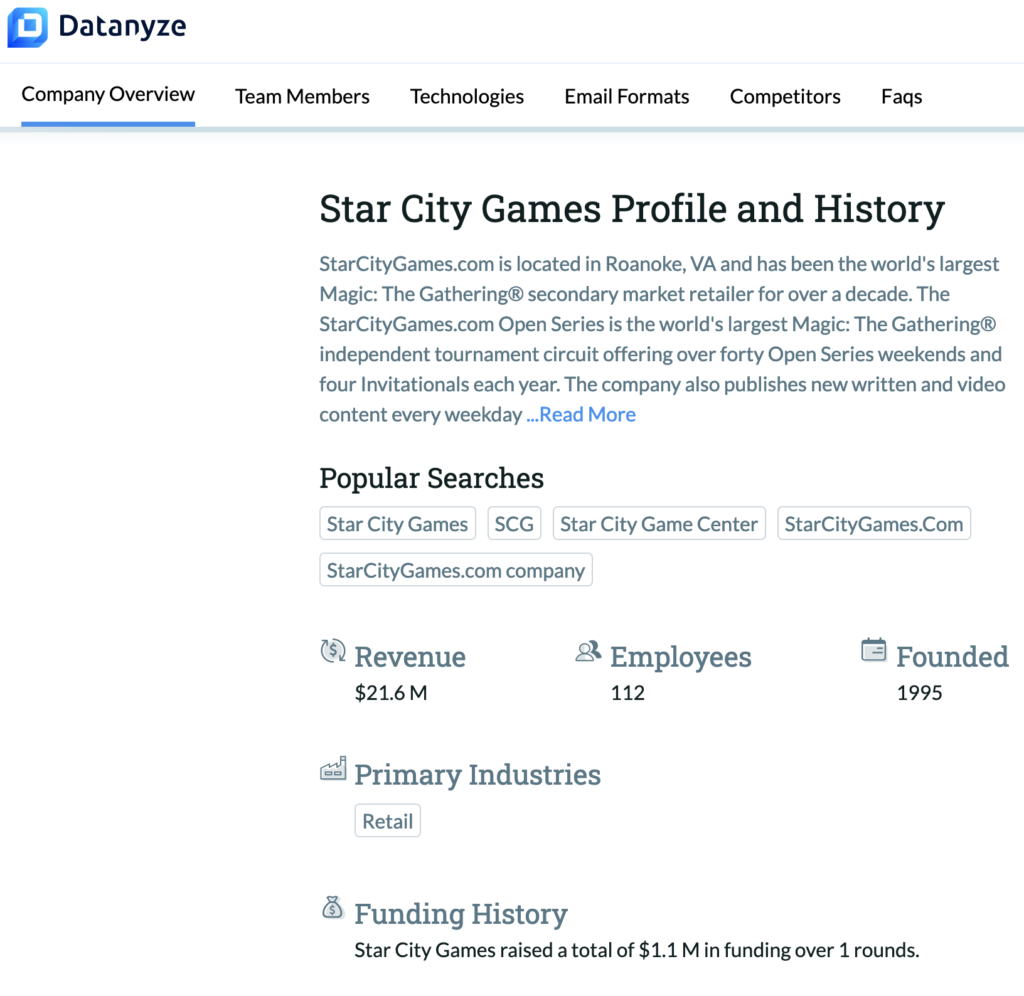
Estimates from www.datanyze.com
This kind of information is hard to evaluate as a journalist, especially because there’s no context. Is this annual revenue? Quarterly? Over a period of 20 years? No one knows, and since SCG remains a private corporation they have no need to tell anyone. There are many websites that do this, and while I’m not about to spend money on any of them, their public information seems to be in consensus that SCG’s revenue is somewhere around $20M (probably annually), they have approximately 100 employees, and at some point they raised $1.1M in funding.
What’s most important for this discussion is the industry in which Star City Games operates: retail. SCG is not selling you content. They are not selling you Gerry Thompson. They are not selling sideboard guides or breaking news or tournament reports or previews.
Content Sells Cards
Star City Games sells Magic: the Gathering singles, sealed product, and gaming supplies. Everything else is a marketing tool to get people to buy Magic: the Gathering singles and sealed product. SCG Con? An opportunity to push more singles and product. The SCG Open series? Singles and product. Premium content subscriptions? Say it with me: “Magic singles and product.”
So now, we come to the real question, the very first thing I asked my colleague when he sent me a link to Gerry’s tweet:
How much money do you think Gerry made for Star City Games when people bought singles after reading his articles?
Go on, think about it for a moment. Roughly 1.5 million people read Star City Games every month (thanks again, weird internet sites that estimate other companies’ operations). If 2% of them read Gerry’s articles that’s 30,000 people. If 1% of those people every month make a purchase from Star City Games that’s 300 people. If they spend $100 on average, then Gerry has earned Star City Games $30,000 in gross revenue monthly.
Are you outraged about Gerry getting a 13% cut of that estimated cash?
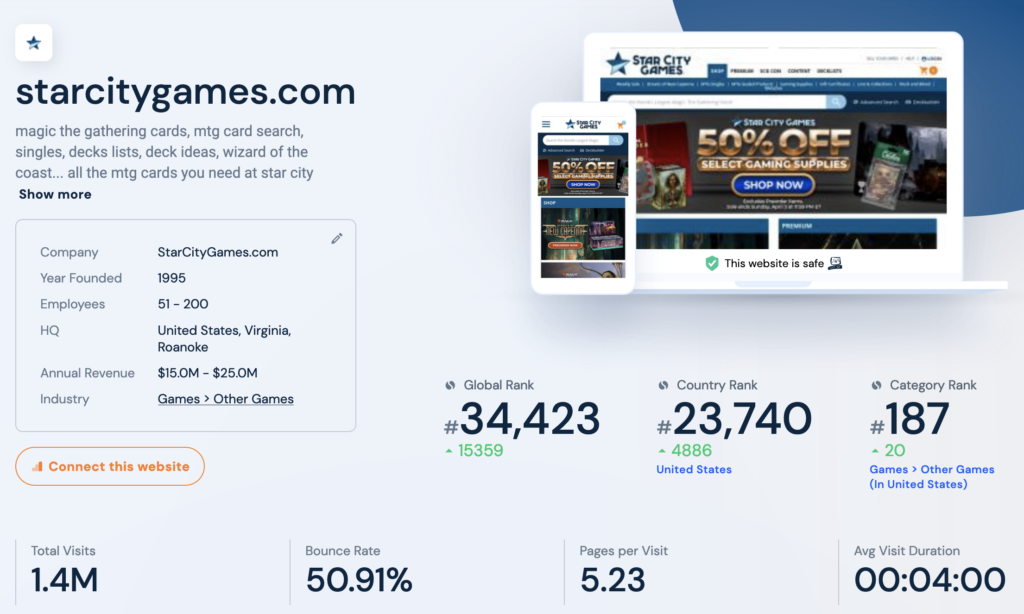
Free analysis from similarweb.com
Of course SCG has bills and (approximately 100) employees to pay and all that jazz. And Gerry doesn’t bring in all of that revenue himself. Many incredibly hard-working people at SCG ensure that orders get fulfilled, the website runs properly, and their reputation in the community for doing good business is preserved. It’s a group effort, no doubt.
But is Gerry’s content worth only 13% of the estimated revenue that it brings directly into the company?
When you work in marketing, the return on investment from your marketing expenditures is one of the primary measurements of the success of a campaign. If you spent a marketing budget of $4,000 a month and your return was $30,000, that’s a 6.5x return. Generally speaking a return of 5x is good work.
My numbers of course are speculation and informed only by a handful of unsubstantiated internet sources. But theoretical numbers aside, the point should be clear: Gerry’s job wasn’t “just” writing articles—it was creating a marketing vehicle for the sale of singles and product by Star City Games. The value of the content and the value of Gerry’s time as a content creator cannot be separated from the reality of the business model in which that content was produced.
Gerry said he made $1,000 per article, writing weekly, to create Magic content. As a full time job that shakes out to $25 an hour. That’s not bad for writing and feels on-par with some types of journalism. But, in my view, he was paid $25 an hour to create marketing campaigns for Star City Games’ primary retail product. And he was almost certainly very, very, good at his job. And I can assure you, marketers who are very, very, good at their job make a lot more than $25 an hour.

